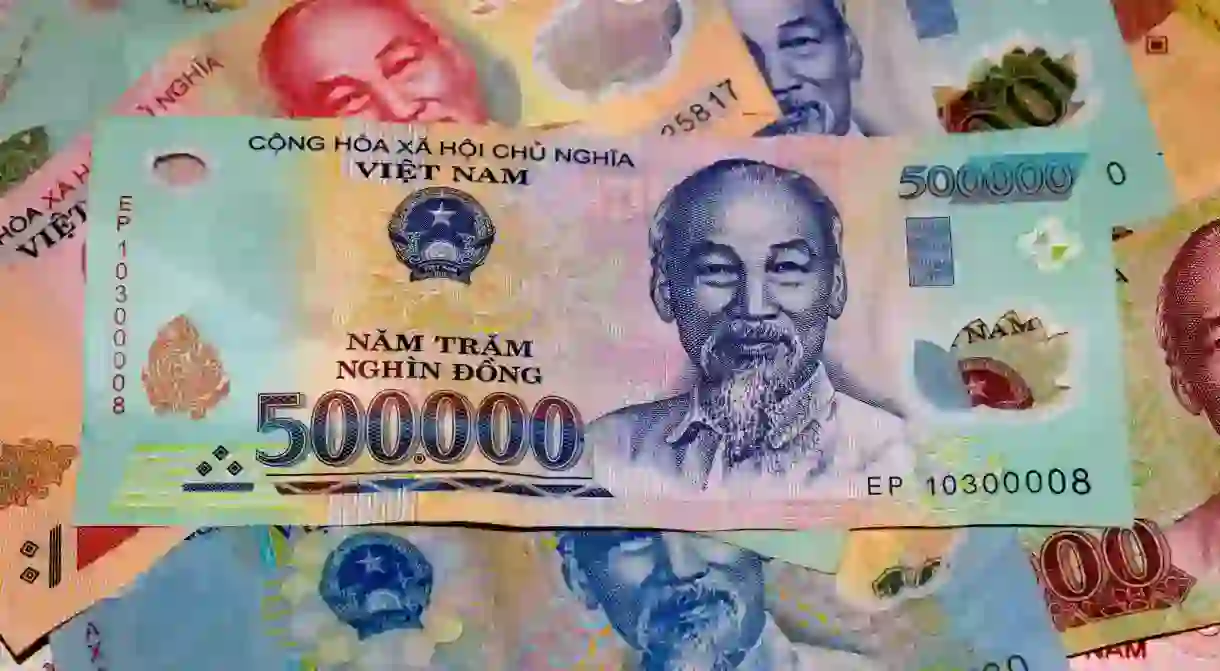VND: Explaining Vietnam's Currency

Officially, the currency goes by the name Vietnam đồng (VND or ₫). The modern version of the đồng, unified after the fall of Saigon, will turn 40 years old in 2018. Here’s the story behind all those zeros.
The history
The etymology is traceable back to the Chinese word ‘tóng qián’, which referred to the bronze coins used during the dynastic eras in both China and Vietnam. The Vietnamese called their coins, ‘đồng tiền.’ Today, đồng refers to just their currency, and tiền is the Vietnamese word for money.

The birth of the đồng came in 1946, shortly after Ho Chi Minh and the Viet Minh issued their famous proclamation of independence in Hanoi. Their new currency replaced the French piastre de commerce, exchanged at a ratio of 1:1. But, after two revaluations — one in 1951, the other in 1958 — the đồng was worth just 1/1000th of a French Indochina piastre.
After the fall of Saigon in 1975, the currency of South Vietnam became the ‘liberation đồng’, which was worth 500 of the old southern đồng. In 1978, the government unified the southern and northern versions into a single currency. This is the iteration that’s still in use today.

Vietnam, suffering from extreme poverty, enacted the policy of Đổi Mới in 1986. It broke the state’s absolute grip on the economy, allowing for a socialist-oriented market economy. Vietnam began to trade with the broader world, but their economy was still in shambles. Then came the dissolution of their strongest ally, Soviet Russia, in 1991. Vietnam continued to struggle, and as a result, their currency plummeted in value.
By 2010, the runaway inflation had stabilised. Vietnam had attracted global manufacturers to set up factories here, and Vietnamese companies had finally matured enough to be competitive in foreign markets. Although the đồng is still one of the least valued currencies in the world, there is no longer fear of a massive devaluation. Many people still prefer to keep foreign currencies rather than đồng, but all street-level transactions are done in local currency.
The coins
The first unified đồng coins were issued in 1978. They were aluminum, minted in East Germany. Because of chronic inflation, the state bank of Vietnam stopped circulating coins until the end of 2003, when they released newly minted coins in 200, 500, 1,000, 2,000, and 5,000 đồng denominations. But, despite laws to force companies and banks to accept them, coins are widely regarded as collector’s items rather than actual money. For example, a 200-đồng coin is only worth 0.000044 USD today, in 2017.
Banknotes
When the state bank of the new Socialist Republic of Vietnam unified the đồng after the fall of Saigon, they released banknotes in denominations of 1, 5, 10, 20, and 50 đồng. In 1985, the bank halted circulation of the old banknotes and issued new ones, which were worth 10 of the previous đồng. Inflation soon forced the government to release new banknotes up to 5,000 đồng in 1987 — up to 50,000 đồng in 1990. By 2003, there were 500,000 đồng banknotes.
Today, all the denominations above 10,000 đồng in circulation are polymer. Cotton versions are still out there, but people tend to hold onto them for nostalgia. And even though the bank stopped production of the smaller denomination cotton banknotes — 5,000 đồng and under — they’re still in circulation and widely accepted. Stylistically speaking, the older notes were light, with colors printed onto them. The modern polymer notes are colorful, similar in look and feel to newer banknotes around the world.

How to say it
You pronounce it: ‘dawm’ (/dɒŋ/ if you’d prefer phonetics). The accent over the letter ô is a diminishing tone, which means you let your voice droop. Think of it like the tone you use when you’re disappointed and you say, ‘Oh…’
The VND today
Even as many countries around the world shift to electronic transactions, embracing varying degrees of a cashless society, Vietnam still runs on cash. A lot of Vietnam’s economy is off the grid, so to speak. People pay for most things in cash, and a thick stack of 500,000 VND notes is a common sight in business.

For several decades now, the đồng has been pegged to the US Dollar. It’s a movable peg, though, which means the government and the state bank can still revalue the đồng when they see fit. As we come to the end of 2017, an American Dollar is worth 22,684 đồng.
The currency has been revalued five times since 2014, but the adjustments have been small, and the prevailing belief is that the state bank won’t need to take any drastic monetary action in the near future. The days of rampant inflation are gone, and despite the laughter of newcomers when they jokingly call themselves millionaires, the đồng isn’t the pariah it once was.













